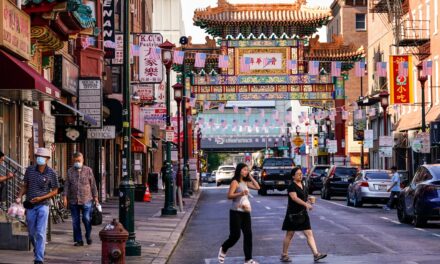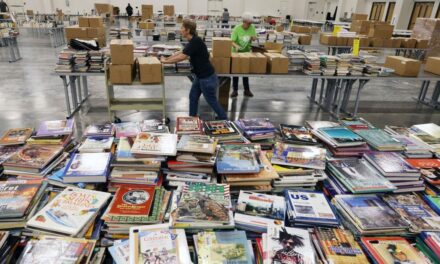
The 76ers’ controversial plan to build a new basketball arena on East Market Street in Center City took a big step this week with the release of four studies on the project’s potential impact.
Whether it was a step forward, backward, or sideways, though, is hard to say.
The studies seem to support arguments that both supporters and critics of the plan have been making since the team’s development arm, 76DevCo, proposed the 18,000-seat venue at 10th and Market two years ago.
A community impact study found evidence the arena, called 76 Place, would accelerate gentrification in neighboring Chinatown and harm businesses there, while an economic analysis concluded it would produce hundreds of millions of dollars in tax revenue — although less than the team has previously claimed.
But the bigger significance of the studies finally being released, some eight months late, may be that City Council can now take up the complex package of bills needed to allow the $1.55 billion project to proceed — and that councilmembers and Mayor Cherelle Parker will have to commit to either advancing or blocking the plan.
Councilmember Mark Squilla, whose district includes the proposed arena site, said he wants to release the enabling legislation as soon as possible to give residents enough time to review the bills. They’re being crafted by the 76ers and several city and state agencies.
“Is this project an opportunity or is it a killer? I think we have to look at those things through the studies,” Squilla said Tuesday on WHYY’s “Studio 2.”
Here’s a rundown of the new studies and how we got to this point.
A “significant” threat to Chinatown’s identity
A coalition of Chinatown businesses, residents, and community groups has been vehemently protesting the arena plan since it was proposed.
They describe it as the latest of several development projects and proposals over the years that have harmed or threatened to harm the treasured ethnic enclave, like the construction of Vine Street Expressway in the 1950s and the adjoining highway in the 1980s.
 Chinatown community members marked the one-year anniversary of a proposal to build a basketball arena in Chinatown with a press conference denouncing the development process. July 21, 2023. (Kimberly Paynter/WHYY)
Chinatown community members marked the one-year anniversary of a proposal to build a basketball arena in Chinatown with a press conference denouncing the development process. July 21, 2023. (Kimberly Paynter/WHYY)
The community impact study, conducted by consultants hired by the city, seems to back up those worries.
“While the Project would not lead to direct housing displacement (meaning no housing would be torn down to build the proposed arena), there is evidence for potential indirect displacement through gentrification and loss of cultural identity in Chinatown, which would likely be accelerated by the proposed project,” the document says.
“Given Chinatown‘s tightly interwoven cultural and social network and the incompatibility of many important businesses with the Arena, the Project impact may negatively interfere with Chinatown‘s goals,” another section reads. “In other words, due to impact on labor markets and small businesses, Chinatown’s core identity could be significantly diminished or lost.”
One of every five small businesses in Chinatown — mainly restaurants, hotels and entertainment venues — could benefit from their proximity to the arena, the analysis found. But half of all businesses — including grocery stores, healthcare providers, and banks — may “experience negative impacts.”
The 136-page report extensively documents current economic, cultural, and infrastructure conditions in the area, as well as the experiences of other places such as Washington D.C., where construction of an arena hastened the near-erasure of the city’s Chinatown district.
Studies bad, studies good
Part of the argument for building the arena at 10th and Market is that it could help revitalize the economically stagnant East Market corridor, which includes the struggling Fashion District — the former Gallery mall — that the arena would be built over and partially replace.
But the community impact analysis said it was far from clear that approach would succeed.
 A rendering of the exterior of the proposed 76 Place arena, released Jun 2023. (Gensler and CBL Real Estate, LLC)
A rendering of the exterior of the proposed 76 Place arena, released Jun 2023. (Gensler and CBL Real Estate, LLC)
“Impacts on Market East are inconclusive – with or without 76 Place, the area will continue to face significant challenges to development and vibrancy,” wrote Martine DeCamp, interim executive director of the Planning Commission, in a letter prefacing the study.
“Development of the Arena, however, provides the opportunity with additional planning and intervention to reinvigorate the Market East retail corridor if transportation and safety challenges can be met,” she wrote.
The Save Chinatown Coalition had preemptively dismissed the studies as flawed and misleading because, while commissioned by the city, they were paid for by the 76ers. “These studies are more focused on justifying the arena than analyzing it,” the group has said.
But this week the coalition tentatively embraced the community impact findings that seem to support its critical position.
“Impact Studies Show Harms and Risks of 76 Place ‘Outweigh Any Imagined Benefits,’ Despite Study Flaws,” read a press release the group put out Wednesday.
Meanwhile, 76DevCo came to essentially the opposite conclusion. “These findings are more evidence that 76 Place can be developed in a way that protects our neighbors and maximizes benefit to Philadelphia,” the team said in a statement.
A promise of more jobs and tax revenues
Another one of the studies, the economic analysis, says the city, schools, and state would net $390 million in tax revenue over 30 years if the arena is built, or close to $1.1 billion if inflation and other factors are accounted for. That’s substantially less than the $1.5 billion, with inflation, that 76Devco has said it would produce.
The report also looks at how much money would be spent on wages and salaries for workers who build the arena and those employed there over a 30-year period. Those 710 jobs would generate $1.9 billion in new spending in Philadelphia, it says; adding in the impact outside of the city brings the job total to 1,070 in Pennsylvania, for a total of $2.5 billion in spending.
The figures do not include indirect spending, for example on meals the workers would buy at restaurants in the neighborhood.
A key part of the analysis is a detailed examination of the market for concerts, Disney on Ice performances, Cirque de Soleil shows, college basketball games, and other events that would take place in the building on days when the 76ers aren’t playing there.
It concludes that Philadelphia can support two similar venues at once — both 76 Place and the team’s current home, the Wells Fargo Center in South Philly — and would see 53 more events per year that draw 613,000 attendees.
More profit for the Sixers, less for Comcast Spectacor
76DevCo officials said they were still reading through all the studies, but argued “it is clear already that they support what we’ve said since we first announced 76 Place: the arena is an appropriate use for Center City and will generate significant new jobs and tax revenue because Philadelphia can support two arenas.”
The Save Chinatown Coalition dismissed the studies as worthless PR exercises by the team, and many outside experts say that arenas and stadiums generally do not turn out to be the economic engines their developers promise.
“This is sort of your old con — like the Music Man or Lyle Lanely and the monorail on The Simpsons. It’s just sort of ‘how can we convince you that this is a good idea?’ and then once it’s implemented, we can walk away from it,” JC Bradbury, an economics professor at Kennesaw State University, told WHYY’s PlanPhilly.
One section of the economic analysis tries to estimate at least part of the 76ers’ potential earnings from different types of events at the new area. Ticket fees could amount to $4.7 million a year and facility fees another $1.2 million, it says.
 The Wells Fargo Center, home of the Philadelphia Flyers NHL hockey team and the Philadelphia 76ers NBA team. March 14, 2020. (AP Photo/Matt Slocum, File)
The Wells Fargo Center, home of the Philadelphia Flyers NHL hockey team and the Philadelphia 76ers NBA team. March 14, 2020. (AP Photo/Matt Slocum, File)
What’s less clear is how losing the Sixers would affect attendance at the Wells Fargo Center and revenue to its owner, Comcast Spectacor, along with the associated tax payments, jobs, and other economic benefits.
It finds that the center “would be negatively impacted,” losing 15% to 25% of its revenue from suite sales, 20% to 30% of naming rights value, and 25% to 35% of rent, concessions, parking and ticket fee revenues. But the analysis doesn’t put a dollar value on those losses or discuss the negative effect on tax collections and employment.
Pushing transit over driving will be critical
The other two reports are a traffic impact analysis and a design review.
The traffic study finds there’s enough parking garage space nearby to accommodate expected drivers to events. It will also be possible to reach a goal of having 4 in 10 visitors use public transit to get to the arena, which would sit on top of SEPTA’s Jefferson Station.
However, the analysts say a number of transit improvements and other steps, like changes to on-street parking regulations to discourage driving and better rideshare management, would be needed to avoid a traffic nightmare.
“If no more than 40% of attendees drive, traffic operations remain manageable. However, even marginal increases in auto trips above that threshold would result in gridlock at critical intersections,” the study says.
The design consultants, meanwhile, said an arena is “appropriate” for the location. They believe “arenas benefit urban downtowns by attracting crowds on event days and adding to the vitality of the city setting,” they wrote.
They praised a large glass facade planned for the building, saying it will “help activate and enliven the public realm along a major arterial street that has historically been insular in nature, especially since the construction of the Gallery mall.”
Their main criticism was “the lack of a true civic and public open space” outside the building. Unlike most newer NBA and NHL arenas, 76 Place would not have a plaza as a public amenity and place for pre- and post-event gatherings. “The lack of a plaza does not allow for a welcoming ‘front door’ and is a major concern,” they wrote.
The consultants urged the arena designers to carve out more open space or make other changes to create a “more engaging” site, and to narrow a planned bridge over 10th Street. “Currently the bridge reduces daylight and sky exposure, creating an unwelcoming effect for all visitors,” the review says.
Offering community benefits to woo support
Proponents of the 76 Place project, like Councilmember Jimmy Harrity and the Inquirer editorial board, tend to support it because of the jobs it would create and its potential to revitalize East Market, as well as concerns that the team could take up an offer to move to New Jersey instead.
But the plan is ultimately driven by the desire of the team’s ownership group, led by investors Josh Harris and David Blitzer, to get out of the Wells Fargo Center. They want to own their own facility where they, rather than Comcast Spectacor, sell the hot dogs, host the concerts, make their own event schedule and reap the resulting profits.
The 76ers plan to leave their current home in South Philly in 2031, when their current lease expires.
 David Gould, the Sixers’ chief diversity and impact officer, spoke at a press conference about a community benefits agreement at South Kitchen & Bar in March 2023. (Jordan Levy/Billy Penn)
David Gould, the Sixers’ chief diversity and impact officer, spoke at a press conference about a community benefits agreement at South Kitchen & Bar in March 2023. (Jordan Levy/Billy Penn)
To build up support for their plan, 76DevCo has proposed a Community Benefits Agreement that could be worth $50 million — a tad more than the team’s big offseason acquisition, Paul George, will earn in the coming season. The 76ers have said it could fund things like affordable housing, small business loans, and neighborhood services like traffic control and street cleaning.
It’s already sponsoring an organization that will prepare Black building trades workers to compete for contracts to build the facility, promising that 40% of food and beverage concessionaires in the arena will be Black-owned businesses, and launching a $2 million fund to prepare such businesses to operate there.
That helped it win support for the arena from the African American Chamber of Commerce of PA, NJ & DE. The project is also backed by the Eastern Atlantic States Carpenters Union and the city’s Building and Construction Trades Council, whose influential leader Ryan Boyer is a close ally of Mayor Parker.
In addition to the Save Chinatown Coalition, which includes activists from a range of neighborhoods, critics of the plan include councilmembers Kendra Brooks, Nicolas O’Rourke, and Jeffery Young, and, no surprise, Comcast Spectacor.
Comcast wants the Sixers to stay put, and has laid out plans for a $2.5 billion development around the South Philly sports complex that would build stores, restaurants, hotels, and a music venue. In the long term, it could include offices, residences — and a new basketball arena.




